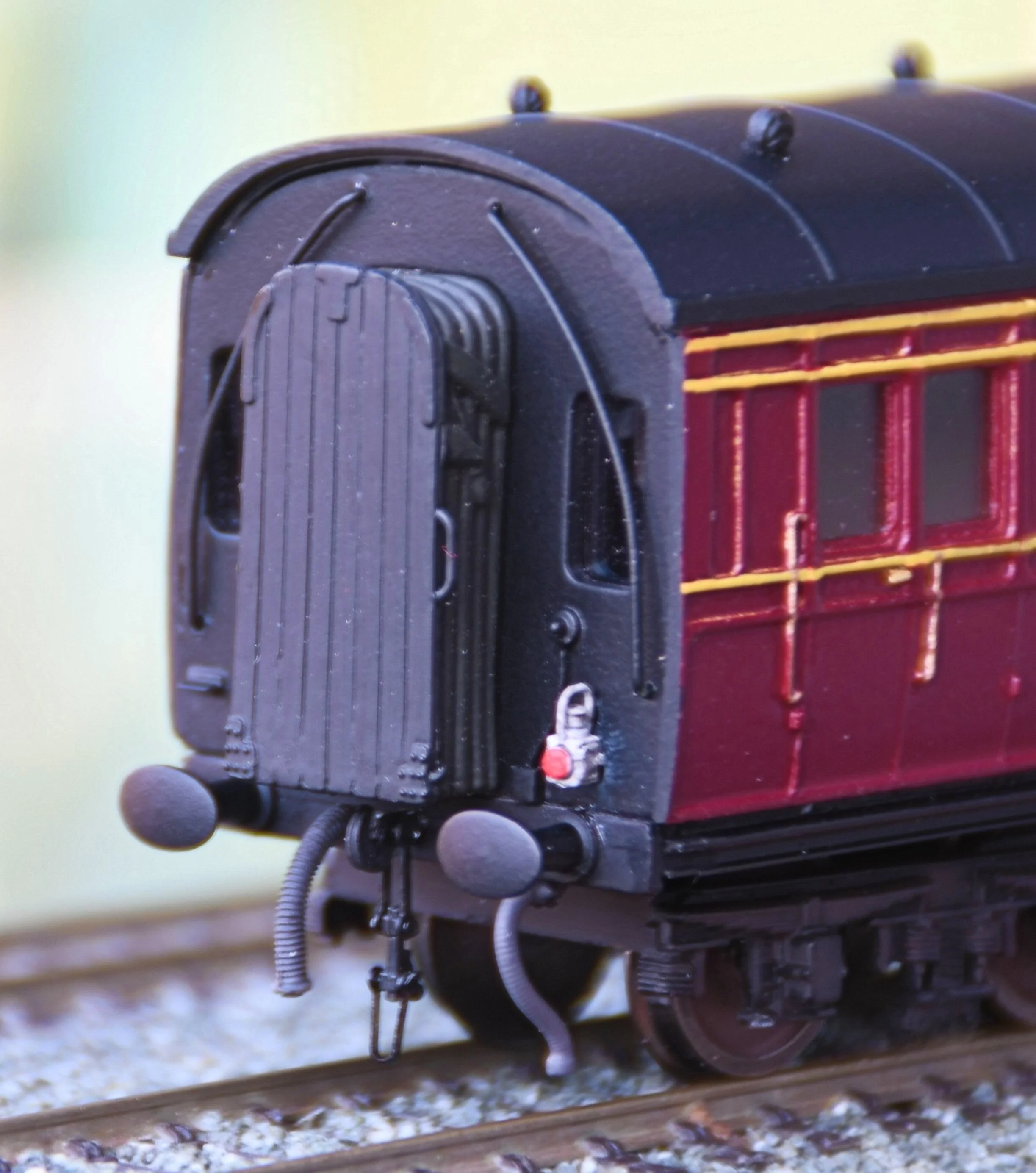A Triang ex-Caledonian Railway 8-wheel Brake Composite re-modelled to run as a 12-wheel LMS through coach
These old Triang coaches will be recognisable to many modellers, being stalwarts at swap-meets and model fairs, even if they are rarely seen running on layouts. The attractive Caledonian livery [above] was first produced on Brake Composite and All-Third coaches between 1962 and 1967 and later released in GWR, SR, LMS and again Caledonian liveries during the very early 1970s. The models were finally was finally withdrawn in 1974. Whilst the sides are a fairly accurate representation of a Caledonian ‘Grampian Stock’ 65ft. Brake Composite, every other part of the coach is pure BR Mark One, the bogies, roof and chassis/ends unit being used for a number of other coaches across the Triang range. These coaches were released without any interior detailing also, making them very basic by contemporary standards.
The prototype coaches were built by the CR between 1903 and 1909 to the design of John McIntosh, the Locomotive Superintendent of the Caledonian Railway, for the Glasgow, Edinburgh and Aberdeen service known as "The Grampian Express". They were 65ft long and built to the extremes of the loading gauge. They ran on 6-wheel bogies due to their weight, were elaborately sprung and the body was mounted on rubber pads to further eliminate noise and vibration. They were also insulated with felt to further reduce noise. Fitted out to luxurious standards they became very popular, and also found service on the Clyde Coast Expresses. These coaches became known as the 'Grampian' stock and four of the Brake Comps. were reserved as through coaches for running between Glasgow and Taunton, via Shrewsbury, and became known as the 'Taunton Brakes'.
The idea behind this project is to produce one of the ‘Taunton Brakes’, in a Period 3 LMS livery, from the above coach. It is speculative at this stage as to whether or not the planned rebuild will be possible as there may just be too much adaptation required to make it viable, so it’s very much a ‘wait and see’ as it progresses. The raw materials for the build comprise:
One Triang Caledonian 65ft. Bk Comp [utilising the sides of the coach and floor only],
One Airfix 57ft Corridor Bk Third [for part of the roof and both ends],
One Airfix 60ft Corridor Comp [for part of the roof],
A pair of Hornby LMS 6-wheel Dining Car bogies [the earlier Dapol ones would do, also], and
detailing from the bits box.
This is the coach that I shall be using, one of the later GWR-liveried issues. The bogies will be removed and the ends of the coach cut away from the chassis. All of the underside detail will be removed, also, leaving a flat, smooth base onto which the new underframe may be built.
And these are the donor LMS coaches. The Airfix Stanier coaches were quite good for their time but Airfix rather burnt their cakes through inconsistent livery application. I managed to obtain this pair for less than £10 via eBay. Whilst I shall only be using a few parts from these coaches, I’ll keep the four bogies for possible future builds as they are to a reasonable LMS pattern.
And work commences. This shows the CR coach taken down into its constituent parts.. The sides, usefully, come away as single units, something which will assist greatly with working on and painting. I’ll keep the roof as it may be possible to adapt it - or part of it - in another future build.
Immediate work will involve carefully cutting the coach ends away from the chassis unit [but leaving the triangular fillets in place], cutting off the bogies and removing every vestige of underframe detail. The coach sides will also have the door droplights enlarged by filing out because they are really too small. Otherwise the sides are extremely close to the prototype.
Later: the chassis unit has been prepared as above. The plastic underframe detail was of an extremely hard material and the only way to remove it was by using Xuron shears and then some very coarse sandpaper. It is now extremely smooth. The ends came away beautifully courtesy of my new and murderously sharp Japanese saw. I’ll need to cut away the mounting bosses for the original Triang bogies, too.























